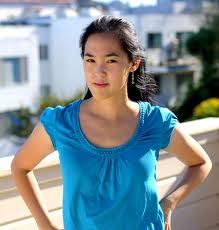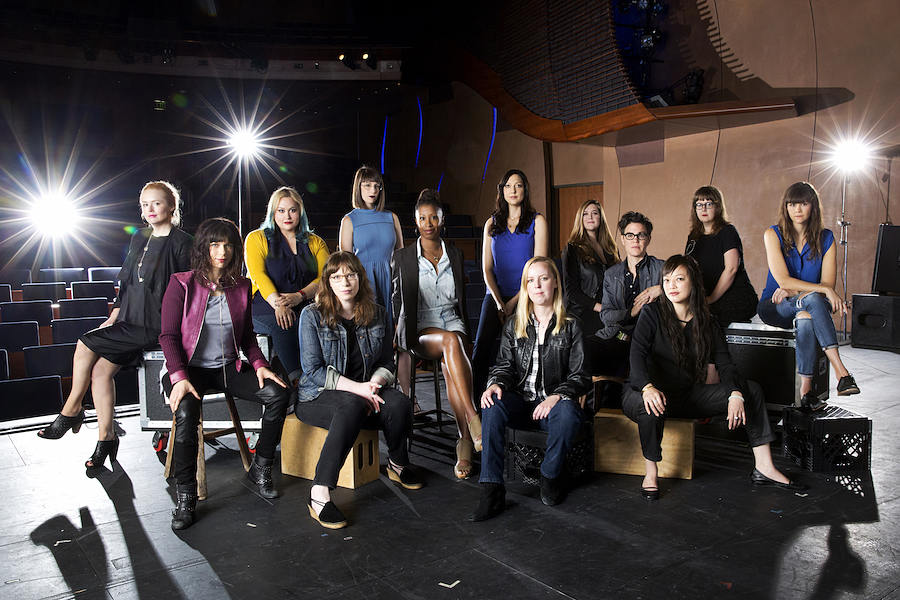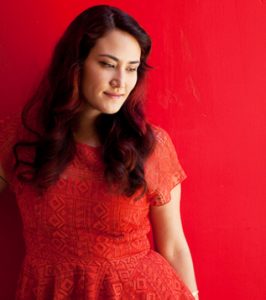It’s Kilroys Day! That’s the special occasion each summer, when the Kilroys release their annual list of new plays by women and transgender writers. On the 2017 List is Lauren Yee, whose plays Cambodian Rock Band and The Great Leap occupy the top two positions on the list. When she found out the news recently, in an in-person interview, she exclaimed, “Yes!” with a smile. “That’s why you’re talking to me,” she says happily. “They didn’t tell me—they just said, ‘You’re on the list.’”

Yee’s plays are two of 37 on this year’s Kilroys List, which were selected based on nominations from 273 industry professionals. This is the fourth year the Kilroys List has been in circulation (a book featuring monologues from 97 Kilroys-endorsed plays is also out now). Since 2014, the List has showcased 131 plays, all nominated by hundreds of industry professionals.
Playwright Susan Soon He Stanton has had plays on the List for the past two years, and she says it has helped introduce her to playwrights she hadn’t heard of before. “It’s been encouraging to look at the List, and I can e-mail people about their plays, and read their plays, which is wonderful,” she enthuses. This year Stanton’s play we, the Invisibles is featured; it’s based on the real-life sexual assault case, New York v. Strauss-Kahn in 2011, in which a hotel maid, Nafissatou Diallo, accused Dominique Strauss-Kahn, director of the International Monetary Fund, of assault and attempted rape.
The Kilroys, who formed in 2013, are a group of Los Angeles-based theatre women who noticed that female playwrights were not produced as much as their male counterparts—and not because they weren’t writing as much.
“We were having a conversation about how ridiculous it was, because there were so many women that we knew that were not being seen by the American theatre,” said Kilroys member Zakiyyah Alexander. “It didn’t mean they didn’t exist; it just meant there was no way for them to be seen.” The group’s name is a reference to the World War II graffiti tag “Kilroy was here,” left by American soldiers in unexpected places.
The Kilroys’ intuition, about the lack of gender parity in the American theatre, was borne out by the numbers. According to a study published in 2015 by the Dramatists Guild of America and the Lilly Awards, between 2011 and 2014, out of 2,508 productions in American theatres, only 22 percent of the plays were written by women (American Theatre has done a similar study every year since 2014; for the 2016-17 season among TCG member theatres, 26 percent of the season’s 1,946 productions were written by women).
To correct that disparity, the Kilroys List was born. Inspired in part by the Hollywood Black List, a survey of notable unproduced screenplays, the Kilroys surveyed a group of industry professionals—typically a mix of artistic directors, literary managers, and dramaturgs—and asked them to nominate good plays by women that either hadn’t been produced or had been, in their estimation, under-recognized. The initial list had a mix of known artists (Paula Vogel, Sheila Callaghan) and newer writers (Rachel Bonds, Jiehae Park).
Every year since, the curation of the List has been slightly different. In 2015, it was expanded to include trans playwrights (both male and female). This year nominators were asked to choose three to five plays by female and trans playwrights of color, and the works had to be either unproduced or have had only one production.
“Women of color are seen the least out of all writers, and the writing involved in our canon especially,” explained Alexander of this new curation method. “We can count how many women writers who have been on Broadway who are black on two hands, and less than that for everyone else.” And with the early closing of Sweat by Lynn Nottage on Broadway, it shows that “at the highest level, women are at a limited run.”
The final 2017 List was then sorted by the play that got the most nominations (Cambodian Rock Band by Yee, with 28), to the one that got the least nominations (Unreliable by Dipika Guha, with 6). Yee’s play is about a Cambodian man who returns home to Cambodia 30 years after the Khmer Rouge, and it features music by Dengue Fever (a Cambodian-American band based in Los Angeles). “The subject matter touches on the Khmer Rouge, Pol Pot, genocide in Cambodia—but it’s not about that,” Yee insisted. “It’s a play about joy and survival, and why we risk so much for music and art.”
The playwright admitted that she hadn’t sent Cambodian Rock Band out to many theatres around the country; it was a commission from South Coast Repertory in California, so only that theatre and Berkeley Repertory Theatre (where the piece was developed) had even read the script. Yee attributed the popularity of the play to its reading in April at SCR’s Pacific Playwrights Festival, where it received a standing ovation.
“When we did the reading at PPF, it was just like, hands down, the most amazing reading I’ve ever had,” she said. “Cambodian Rock Band is not good on paper.” She then pauses and clarifies: “It’s like good on paper, but it’s so much better in performance with the music.” Yee described the music as “Cambodian-flavored psychedelic surf rock.”
Yee also noted that the Cambodian experience is an underrepresented subject in American theatre and culture, which is perhaps one reason for the play’s warm reception. Similarly, Stanton believes that her play, we, the invisibles, was chosen because it was telling a story that had not been heard before on American stages. “I think in this present political climate, it feels more important than ever to make space for these untold stories,” she said.

But the biggest question is: Four years later, has the List moved the needle on gender parity in the American theatre? Alexander replied in the affirmative. “Our goal has been to support a need that, it has been said, is difficult to meet,” she said, referring to the excuse given by many artistic directors that the scarcity of plays on their stages by women is due to a scarcity of female playwrights. “We’ve had a lot writers say, all of a sudden people were reading their plays and there were inquiries. There’s been a micro-shift that’s happening.”
Both Stanton and Yee admitted that they can’t pinpoint any specific productions that have come from inclusion in the List, though the Kilroys say that more than 100 productions have been spurred by the List. The playwrights do think it’s a valuable resource even without the guarantee of productions.
“I think in a more holistic way, it helps to shift the conversation,” said Yee. The curated nature of the List means that the playwrights on it have been endorsed by respected industry professionals. To Yee, the List makes that initial introduction to a new writer that much easier. “You [as a producer] are going to think about it a little differently, with an idea that this is someone who is lauded in the field and who everyone is excited by,” she said. “As opposed to, you meet me—‘Oh, I know who she is, but I don’t know if I want to read it or I don’t know if I’m interested.’ I think in a way overall, it helps to raise all the boats.”

Stanton could point definitively to one area where her profile has been raised by the List: among theatre students, who sent her inquiries looking for audition material or new plays to read. “I write plays that often times have a half-Asian character, and I met a young actor that have never read a play with a hapa before,” she says (Stanton is part Chinese, Korean, and white). Stanton believes that the voices represented on the List, and the stories they tell, can be a source of inspiration for younger artists who have never seen themselves reflected in theatre before. “Plays written by women, especially women of color—it’s a different lens and a variety of stories. You can see your reality and identity reflected on the page in a way that you haven’t before.”
Alexander admitted that it’s going to take more than a list of plays to reach true gender parity. “I don’t feel like our list can change the history of patriarchy that we sort of know to be American theatre,” she said. But she also added that the List has become a point of pride for playwrights, making it into their bios and press materials. Stanton added another crucial group that seems impressed: television producers. “They like the List because it’s like the Black List,” she says.
For female playwrights fighting for visibility in a male-dominated profession, the Kilroys List has become a marker of validation. “Anyone knocking on your door going, ‘I see you, I recognize you, people read your plays,’ that’s a pat on the back that keeps you in the field for a little bit longer,” said Alexander.
The complete Kilroys List for 2017 is below:
Cambodian Rock Band by Lauren Yee
The Great Leap by Lauren Yee
Yoga Play by Dipika Guha
Thirst by C.A. Johnson
Blks. by aziza barnes
If Pretty Hurts Ugly Must Be a Muhfucka by Tori Sampson
Is God Is by Aleshea Harris
We, the Invisibles by Susan Soon He Stanton
Queen by Madhuri Shekar
The Opportunities of Extinction by Sam Chanse
Hang Man by Stacy Amma Osei-Kuffour
Last Night and the Night Before by Donnetta Lavinia Grays
El Huracán by Charise Castro Smith
Two Mile Hollow by Leah Nanako Winkler
Black Super Hero Magic Mama by Inda Craig-Galván
Endlings by Celine Song
Eve’s Song by Patricia Ione Lloyd
To the Yellow House by Kimber Lee
Florissant & Canfield by Kristiana Rae Colón
Les Freres by Sandra A. Daley-Sharif
Redwood by Brittany K. Allen
Burned by Amina Henry
Hatefuck by Rehana Lew Mirza
Magic City or Julie in Basel by Hilary Bettis
Nomad Motel by Carla Ching
Noura by Heather Raffo
Usual Girls by Ming Peiffer
Azul by Christina Quintana
Breach by Antoinette Nwandu
How to Catch Creation by Christina Anderson
Nike, or We Don’t Need Another Hero by Ngozi Anyanwu
Selling Kabul by Sylvia Khoury
Somebody’s Daughter by Chisa Hutchinson
The Homecoming Queen by Ngozi Anyanwu
The Paper Dreams of Harry Chin by Jessica Huang
The Thanksgiving Play by Larissa FastHorse
Unreliable by Dipika Guha


